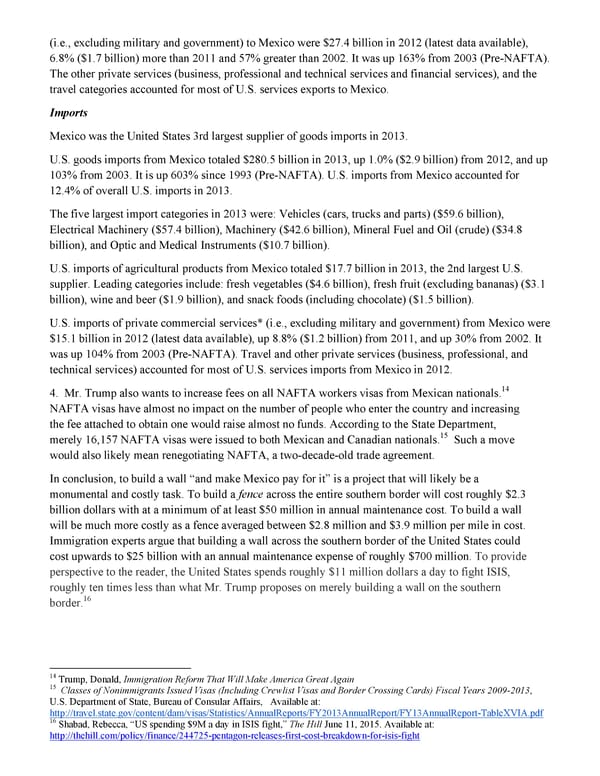(i.e., excluding military and government) to Mexico were $27.4 billion in 2012 (latest data available), 6.8% ($1.7 billion) more than 2011 and 57% greater than 2002. It was up 163% from 2003 (Pre-NAFTA). The other private services (business, professional and technical services and financial services), and the travel categories accounted for most of U.S. services exports to Mexico. Imports Mexico was the United States 3rd largest supplier of goods imports in 2013. U.S. goods imports from Mexico totaled $280.5 billion in 2013, up 1.0% ($2.9 billion) from 2012, and up 103% from 2003. It is up 603% since 1993 (Pre-NAFTA). U.S. imports from Mexico accounted for 12.4% of overall U.S. imports in 2013. The five largest import categories in 2013 were: Vehicles (cars, trucks and parts) ($59.6 billion), Electrical Machinery ($57.4 billion), Machinery ($42.6 billion), Mineral Fuel and Oil (crude) ($34.8 billion), and Optic and Medical Instruments ($10.7 billion). U.S. imports of agricultural products from Mexico totaled $17.7 billion in 2013, the 2nd largest U.S. supplier. Leading categories include: fresh vegetables ($4.6 billion), fresh fruit (excluding bananas) ($3.1 billion), wine and beer ($1.9 billion), and snack foods (including chocolate) ($1.5 billion). U.S. imports of private commercial services* (i.e., excluding military and government) from Mexico were $15.1 billion in 2012 (latest data available), up 8.8% ($1.2 billion) from 2011, and up 30% from 2002. It was up 104% from 2003 (Pre-NAFTA). Travel and other private services (business, professional, and technical services) accounted for most of U.S. services imports from Mexico in 2012. 14 4. Mr. Trump also wants to increase fees on all NAFTA workers visas from Mexican nationals. NAFTA visas have almost no impact on the number of people who enter the country and increasing the fee attached to obtain one would raise almost no funds. According to the State Department, 15 merely 16,157 NAFTA visas were issued to both Mexican and Canadian nationals. Such a move would also likely mean renegotiating NAFTA, a two-decade-old trade agreement. In conclusion, to build a wall “and make Mexico pay for it” is a project that will likely be a monumental and costly task. To build a fence across the entire southern border will cost roughly $2.3 billion dollars with at a minimum of at least $50 million in annual maintenance cost. To build a wall will be much more costly as a fence averaged between $2.8 million and $3.9 million per mile in cost. Immigration experts argue that building a wall across the southern border of the United States could cost upwards to $25 billion with an annual maintenance expense of roughly $700 million. To provide perspective to the reader, the United States spends roughly $11 million dollars a day to fight ISIS, roughly ten times less than what Mr. Trump proposes on merely building a wall on the southern 16 border. 14 Trump, Donald, Immigration Reform That Will Make America Great Again 15 Classes of Nonimmigrants Issued Visas (Including Crewlist Visas and Border Crossing Cards) Fiscal Years 2009-2013, U.S. Department of State, Bureau of Consular Affairs, Available at: http://travel.state.gov/content/dam/visas/Statistics/AnnualReports/FY2013AnnualReport/FY13AnnualReport-TableXVIA.pdf 16 Shabad, Rebecca, “US spending $9M a day in ISIS fight,” The Hill June 11, 2015. Available at: http://thehill.com/policy/finance/244725-pentagon-releases-first-cost-breakdown-for-isis-fight
 THE $900 BILLION QUESTION: ILLEGAL IMMIGRATION Page 5 Page 7
THE $900 BILLION QUESTION: ILLEGAL IMMIGRATION Page 5 Page 7